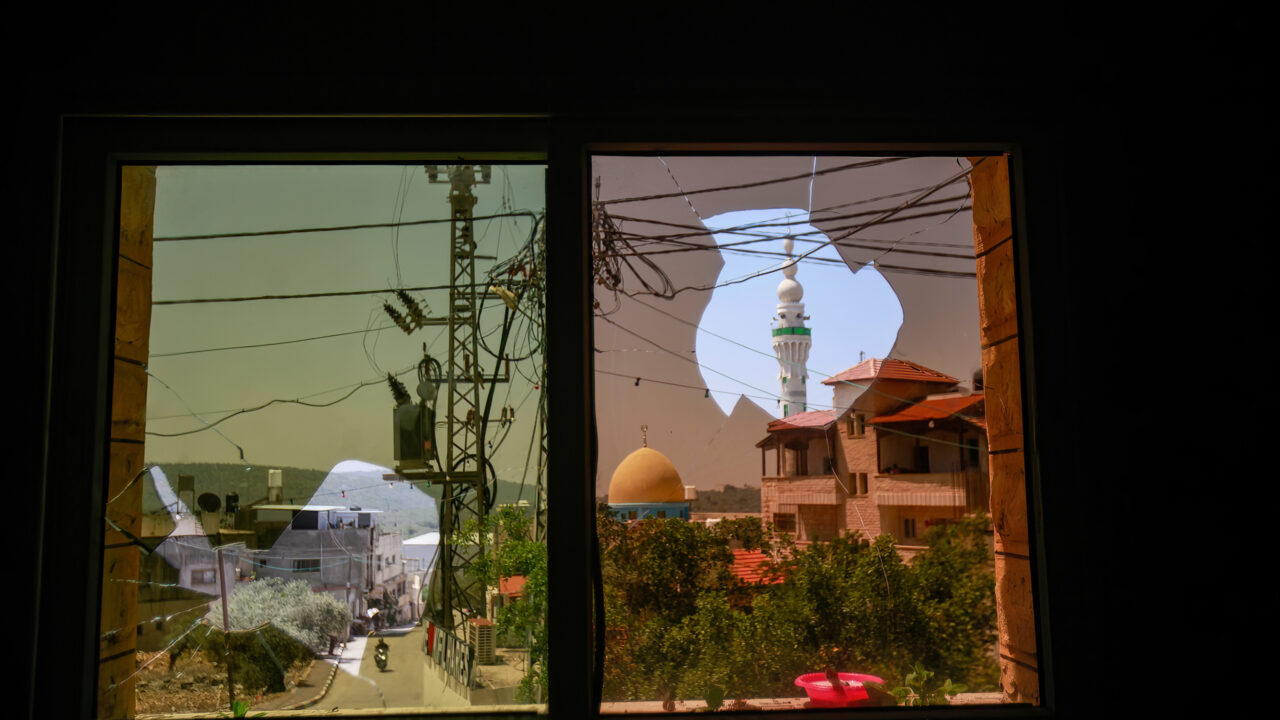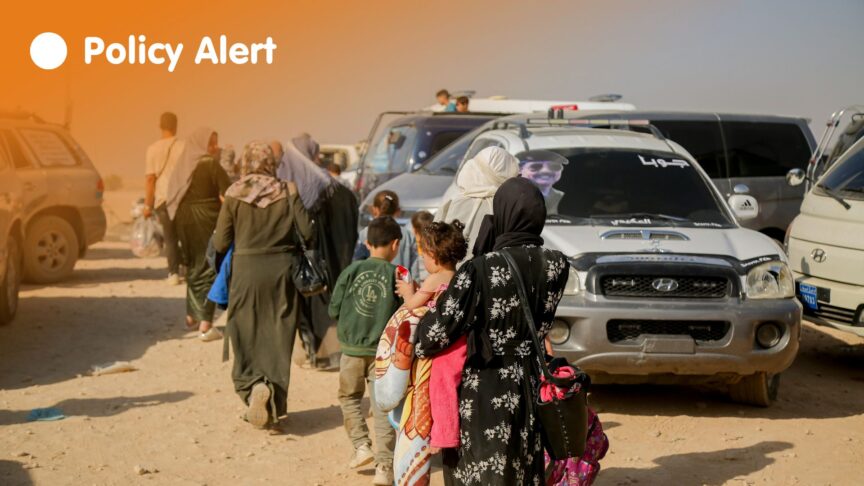Regional ripple effect: How escalating Israeli-Palestinian violence risks a new Arab-Israeli conflict
Recent fighting on Israel’s borders with Lebanon and Syria shows how spiralling Israeli-Palestinian violence could drag the region into a renewed war
The brief eruption of fighting on Israel’s borders with Lebanon and Syria in early April was a stark demonstration of the interlocking local and regional dynamics driving Israeli-Palestinian violence. As Palestinian groups and Israel increasingly export their conflict to neighbouring countries, Iran and its regional allies continue to see the Israeli-Palestinian arena as an extension of their own confrontation against Israel. Although no party wants uncontrolled escalation at present, these dynamics threaten to drag neighbouring Arab countries into an unwanted war.
On 6 April, 34 rockets were fired on northern Israeli towns from southern Lebanon – marking the largest escalation between the two countries since the end of the 2006 war. No group claimed responsibility, but the Israeli military soon pointed the finger at two Palestinian armed groups: Hamas and Islamic Jihad (PIJ). The day before, both had warned that the repression of Muslim worshippers in Jerusalem’s al-Aqsa mosque by Israeli security forces would lead to escalation.
Hizbullah denied involvement but it is unlikely that any such attack could have happened without its greenlight given its complete dominance of Lebanon’s south and close cooperation with Hamas and PIJ. This was on full display the day after the attack, when a Hamas delegation led by the group’s chairman, Ismail Haniyeh, met Hizbullah secretary general, Hassan Nasrallah, in Beirut.
Hamas wants to avoid dragging Gaza into a war with Israel as happened in May 2021, when Hamas and PIJ responded to Israeli violence on the holy esplanade with rocket fire, triggering a destructive two-week war with Israel. Hamas has little desire for renewed escalation in Gaza – which remains trapped in a socio-economic crisis – as long as Israel continues to incrementally loosen some aspects of its blockade as per the fragile ceasefire deal that ended the last round of fighting. Instead, the Islamist group has sought to encourage attacks in Israel, East Jerusalem, and the West Bank. It may now see strategic value in opening a third front against Israel from Lebanon.
PIJ has likewise reoriented its operations away from Gaza in light of Hamas’ continued enforcement of the ceasefire deal with Israel. It is especially active in the West Bank where its strength has grown thanks to a reported influx of funding from Iran. There are now signs that it too may be shifting its operations to the north. In addition to having a reported hand in the rocket fire from southern Lebanon, it was allegedly behind a similar cross-border attack two days later from Syria against the Israeli-occupied Golan Heights.
Israel’s security officials have long believed a new war on its northern border to be a matter of time. After an unprecedented IED attack on 13 March at Megiddo Junction in northern Israel, officials grew concerned that enemies could exploit the domestic turmoil caused by the Israeli government’s controversial plans for judicial reform to attack the country. The Megiddo bombing was eventually attributed to an obscure Palestinian group supported by Hizbullah and the Syrian regime. Hizbullah may have also allowed Palestinian factions to respond to the violence in al-Aqsa to remind Israel of the military threat it continues to face on its northern border.
The eruption of tensions in the north comes after increased Israeli airstrikes in Syria against targets linked to Hizbullah and its Iranian patron. Although mostly intended to block the transfer of advanced Iranian weapons to Lebanon, the strikes have killed several members of the Iranian Islamic Revolutionary Guards Corps and senior PIJ commanders based in Damascus. Alongside this, Israel has been pursuing a clandestine campaign inside Iran to sabotage Iranian nuclear capabilities and assassinate military officials and scientists.
So far, these Israeli operations have elicited little response from Iran. However, developments in southern Lebanon, combined with attacks by Iranian proxies against US bases in Syria, could constitute a warning signal from Tehran. In a similar vein, last week’s visit by PIJ’s leader, Ziyad al-Nakhalah, to Baghdad for meetings with government officials was likely also an Iranian attempt to portray an expanding regional front against Israel. This comes as Israel and the US discuss the possibility of launching military action against its nuclear programme.
Despite attempting to find new areas to confront each other, all parties appear keen to avoid total war at this time. Hizbullah has shown little appetite for a rerun of its 2006 war with Israel which caused over one thousand deaths and extensive damage to Lebanon’s infrastructure. It can therefore be expected to tightly control the actions of Hamas and PIJ.
The Israeli government has also acted to contain escalation and avoid spiralling conflicts on multiple fronts. Although Israel launched reprisal airstrikes in both southern Lebanon and Gaza, the targets appeared to have been deliberately chosen to avoid casualties. The decision by Israeli authorities to refrain from further armed incursions into al-Aqsa and prevent Jewish visitations to the esplanade during the last ten days of Ramadan was another de-escalatory move.
Hamas has been careful too. While it responded to Israeli airstrikes with limited rocket fire from Gaza, the fact that these were largely aimed away from Israeli towns appeared equally calibrated to avoid another round of escalation. More generally, it does not appear to have yet fully committed itself to all-out confrontation with Israel – reflecting perhaps its continued strategic hedging between armed violence, national reconciliation with its Fatah rival, and aspirational engagement with the European Union. A rare visit by Ismail Haniyeh to Riyadh this week to repair bilateral relations with the gulf monarchy – against the backdrop of detente between Saudi Arabia and Iran – likely also indicates Hamas’ desire to maintain some independence from Iran. In practice this means Hamas decides whether or not to escalate against Israel based on its own interest, and not those of Tehran.
All parties to the recent fighting were quick to signal their desire to return to ‘calm’. But Israel’s prime minister, Benjamin Netanyahu, faces accusations from across the political spectrum that he has weakened Israel’s ability to deter foes. He could be tempted to launch a large-scale military operation to bolster his political position. Meanwhile, Hamas’ relative restraint in the West Bank in comparison to other groups has caused some public criticism and a reported cut in Iranian funding.[1] Its actions in Lebanon could in part be an attempt to safeguard its domestic standing and regional support. And it may decide its interests are best served by further escalation.
The willingness of the parties to escalate to the brink of regional war represents a new and dangerous form of brinkmanship as Iran and Israel expand their proxy war against each other
The willingness of the parties to escalate to the brink of regional war represents a new and dangerous form of brinkmanship as Iran and Israel expand their proxy war against each other. Meanwhile tensions in East Jerusalem and the deteriorating political and military situation in the West Bank will continue to drive Israeli-Palestinian violence along with the threat of broader regional conflagration. Left unchecked, neighbouring countries risk being increasingly caught up in spiralling Israeli-Palestinian violence that will further undermine European aspirations for a negotiated two-state solution to the conflict and broader regional stabilisation.
[1] Author interview with former Islamic Jihad leader, Nablus, March 2023.
The European Council on Foreign Relations does not take collective positions. ECFR publications only represent the views of their individual authors.



